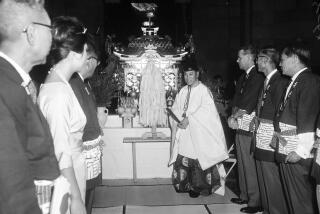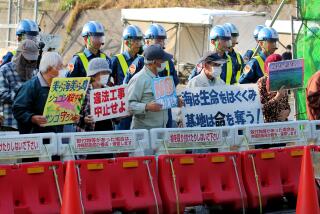Dream Rings True : Japanese-American Helps Return Bell Taken by U.S. in War
- Share via
PORT HUENEME — As a timid Japanese-American bride of a U.S. sailor 30 years ago, Yoshiko Harris said nothing when she noticed that the 900-pound brass bell hanging in the Port Hueneme naval museum had come from her native Okinawa.
But she dreamed of someday sending it back.
Last week, Harris, now 57, was among 50 American and Japanese citizens at a ceremony marking the return of the four-foot-high bell to Oshiro, a small Okinawan farming community in the village of Ozato-Son.
Members of the 147th Naval Construction Battalion had confiscated the bell at the close of World War II as a trophy of the bloody battle that culminated in U.S. forces taking the island.
“Armies have been taking back things since the beginning of time,” said Vincent Transano, base historian and Seabee Museum director. “That’s where museums come from.”
Although Capt. David Nash, commanding officer of Port Hueneme Naval Construction Battalion Center, presided graciously over the ceremony, he uttered no regrets about how the bell came to the United States.
Similarly, the mayor of Ozato-Son and other village officials who traveled to California for the ceremony did not mention that a group of Japanese companies, not the U.S. government, is paying to fly the bell home.
George Sankey, president of the Okinawa Assn. of North America, a group of Okinawans and descendants of the islanders, said of the villagers: “They’re happy to have received it. They want to keep it as quiet as possible until they have received it. Then they will complain.”
Before taking possession of the bell, the villagers doused it with sake and brushed it with a tree branch, part of a traditional purification ceremony.
With the bell smelling faintly of alcohol, it was trucked to Los Angeles International Airport, where a Japanese airline will fly it home.
Back in Oshiro, a community of about 900 people, the bell will be returned to the red-roofed bell house to call meetings, announce funerals and weddings and alert villagers to emergencies.
Sankey said such bells used to be common in Japanese villages until the war, when most were melted to make bullets.
Okinawa, a 70-mile-long island at the southern tip of Japan, was invaded by the United States on Easter Sunday, 1945, starting a three-month battle that claimed an estimated 100,000 Japanese and 12,000 American lives.
After the U.S. victory in the battle, the island did not return to Japanese control until 1972.
The bell had been at Port Hueneme’s Seabee Museum since 1960, when someone, presumably a member of the 147th Battalion, donated it.
Museum officials have no records of how it got to the base or where it was kept between 1945 and 1960, but speculated that a member of the battalion may have stored it at his home.
Harris first saw it in 1962, when her husband was at Port Hueneme. She recognized the Japanese inscription identifying it as belonging to an Oshiro youth association on Okinawa.
She also noticed the date the bell was cast: Sept. 4, 1935.
“I felt strongly about it because it was my birthday,” she said. “All these years, I came in once a month to check it out” and make sure it was safe. “I always hoped that someday, someday. . . . “
But nothing happened until after Harris’ husband retired from the Navy and got a civilian job as curator of the Seabee Museum.
Last summer, Yoshiko Harris happened to meet Eitoku Zamami, an Ozato-Son high school administrator who was visiting Oxnard. After she showed him the bell, Zamami returned home and told the village mayor, who started working to get it back.
The village made a formal request for the bell and quickly got the approval of the U.S. Navy curator, who controls all such artifacts at base museums, Transano said.
More to Read
Sign up for Essential California
The most important California stories and recommendations in your inbox every morning.
You may occasionally receive promotional content from the Los Angeles Times.










